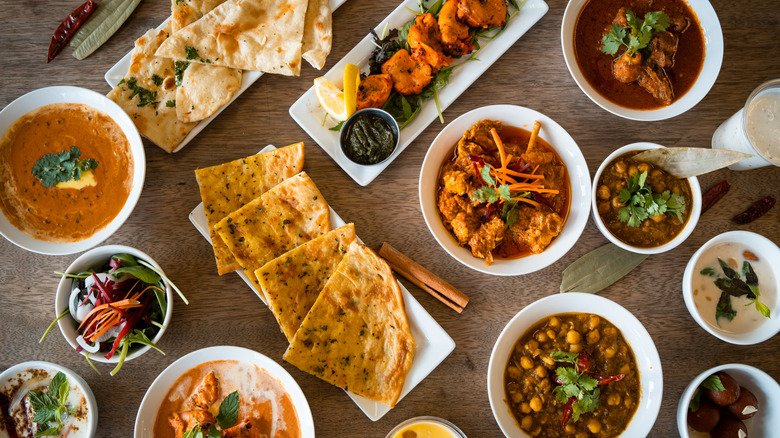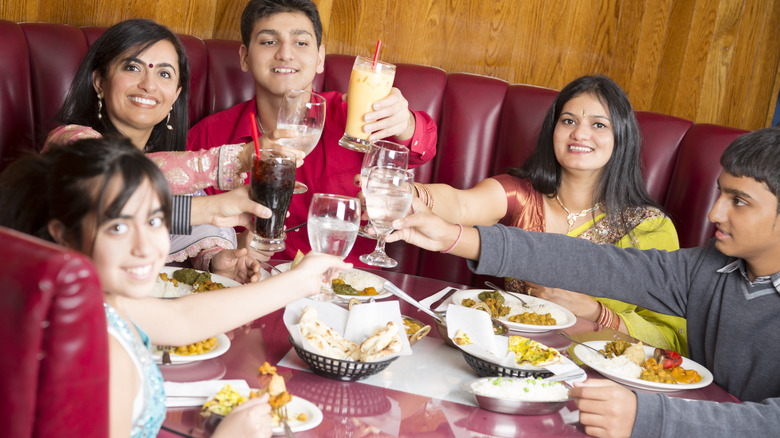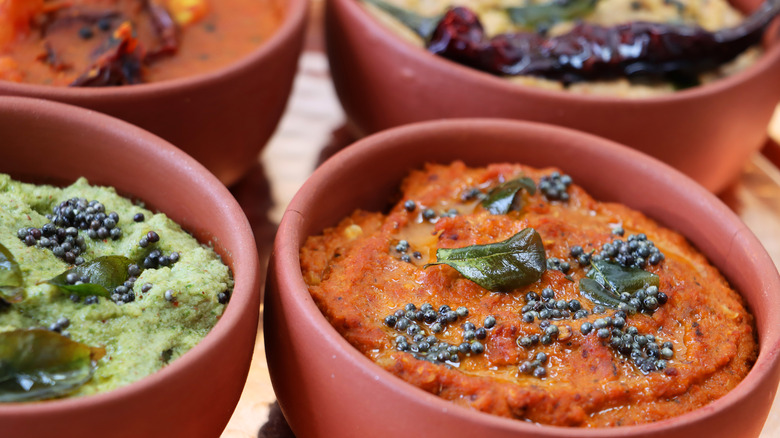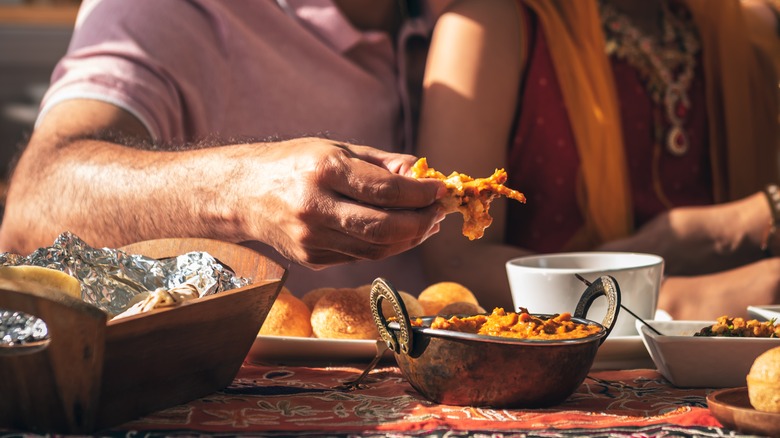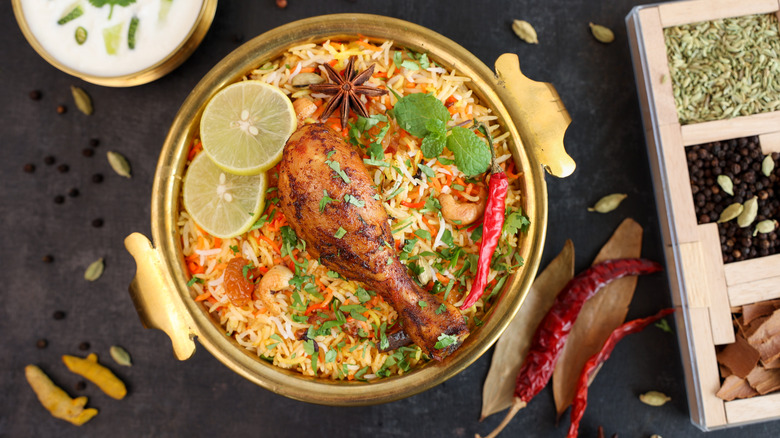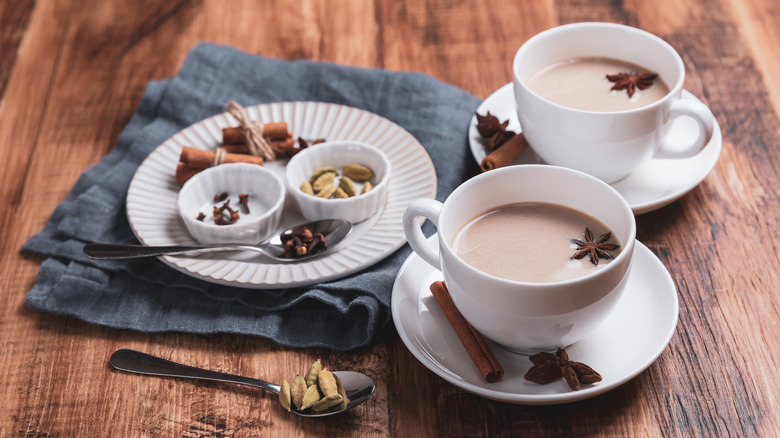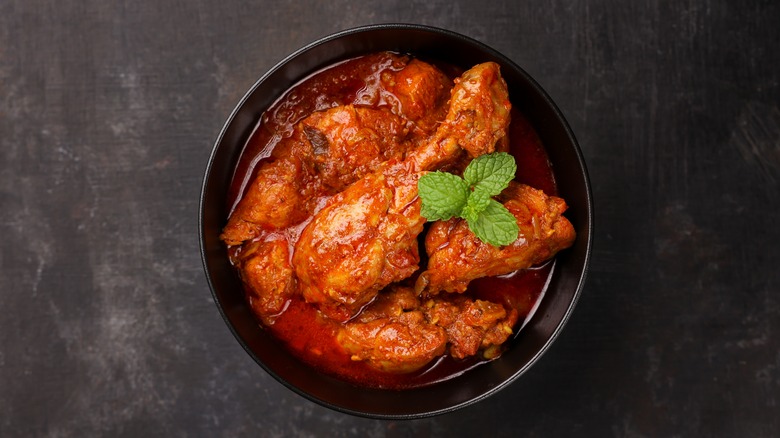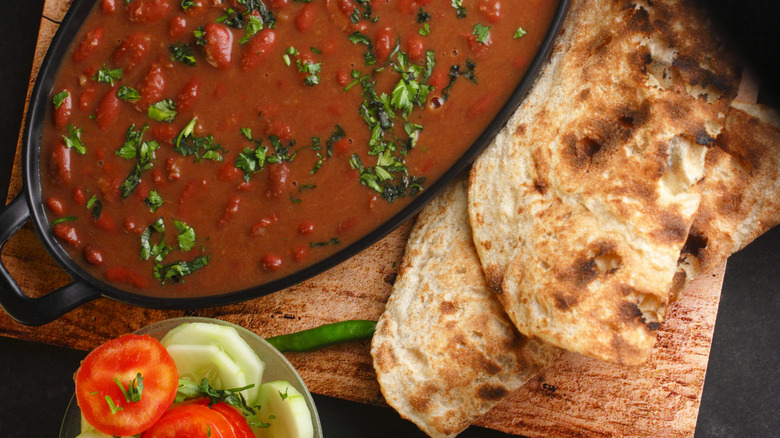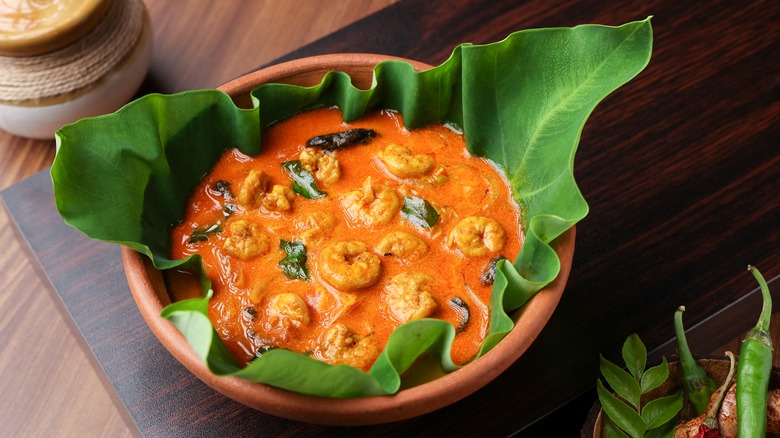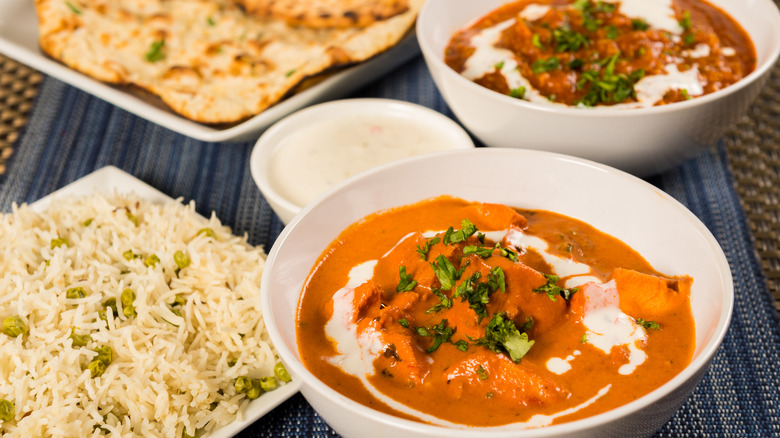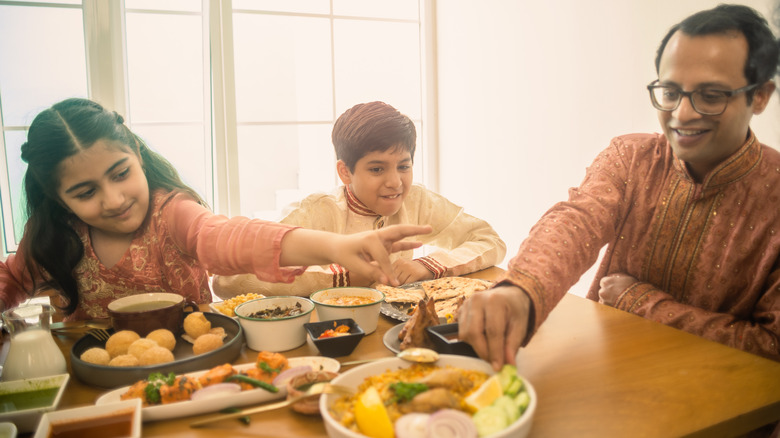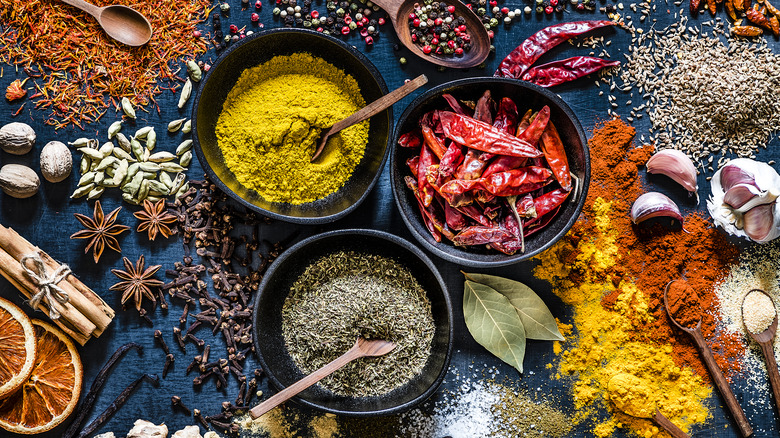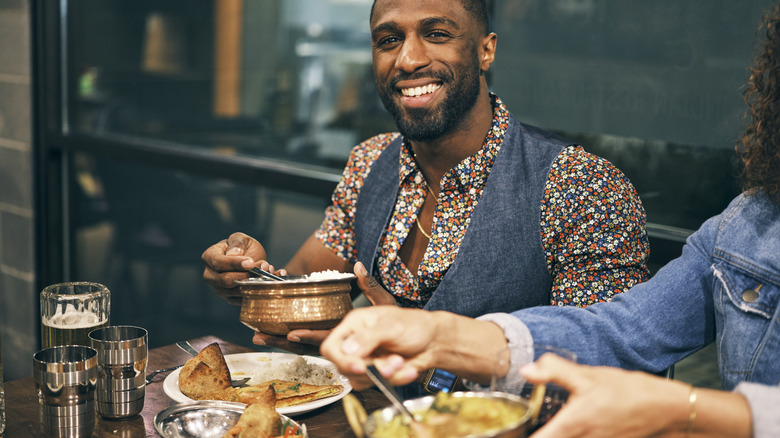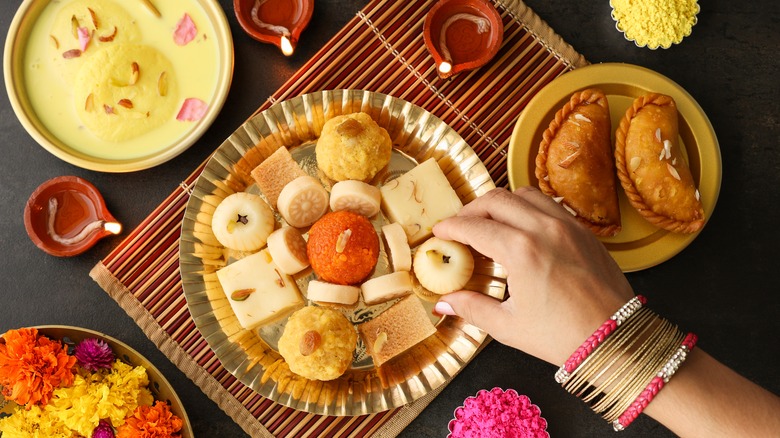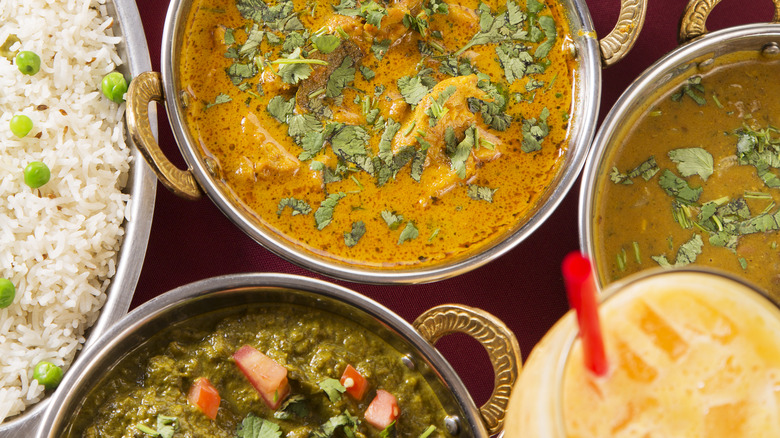15 Mistakes You're Making When Eating At An Indian Restaurant
Whether you're new to trying Indian food or you've been finger-deep in dishes like dahi vada and keema for most of your life, you may not be aware of some of the cultural norms tied to ordering and eating at an Indian restaurant. For instance, you may not realize that it's really not possible to tone down the spice level in some Indian dishes. Likewise, overordering and asking certain dishes to be served together are culturally frowned upon.
The good news is these types of "mistakes" are common. No one's going to kick you out of an eating establishment for overusing the chutney or ordering "naan bread." The problem isn't making the mistake, but instead not taking the time to learn about the culture so you can "get it right" the next time around.
We're using this opportunity to learn from Indian restaurateurs, who gave us insights into best practices, to discover which mistakes stand out as the most common and flagrant when eating at an Indian restaurant.
Not sharing foods
In the Indian culture, meals are communal events and eating at a restaurant is no different. Instead of ordering an entree for yourself, the intent is to actually share the restaurant meals. "A significant misunderstanding lies in perceiving Indian dishes as individual portions; this perspective is quite Western," says Vikram Thadani, owner of Rishtedar in Miami and Chile. "In the East, from Arabia to Japan, meals are typically meant for sharing. That's why they are served in the middle, allowing each person to choose their accompaniment, be it rice or naan."
To that end, perceiving dishes as individual portions rather than communal servings can actually lead to over-ordering eating. "Indian food is best shared and the portion sizes are reflective of that," says Shaun Mehtani, second-generation owner of the Mehtani Restaurant Group. "We often see people coming in and ordering one appetizer, one main course, and bread/rice for themselves, which is an abundant amount of food but is also not what Indian food is all about." So, the next time you head to an Indian restaurant with friends, talk about your order as a group to see which dishes you want to try and share together.
Ordering padpad or chutney as a starter
Sure, when you go to a Mexican restaurant, it's common to order chips and salsa or guacamole as an appetizer to get your meal started. But carrying that line of thinking over to padpad and chutney at an Indian restaurant is a bit of a faux pas.
Papadum crackers (also known as padpad) may mimic the texture and flavor of chips, and chutneys may make for delicious dips, but these two foods together aren't intended to be enjoyed as an appetizer before your Indian entrees are served. "These are not starters to an Indian meal, but rather to be used as sides to bring crunch and texture to dishes," says Chef Surbhi Sahni of Tagmo, an Indian restaurant in New York City.
So don't shy away from ordering your padpad and chutney, just order them with your entrees so you can fully enjoy the textures and flavors across your entire meal — rather than as a separate order to start your lunch or dinner.
Not eating with your hands (the right way)
Eating with your hands may be frowned on at many Western restaurants (for instance, you might get a few sideways glances if you dig into a bowl of pasta with your fingers the next time you go to an Italian restaurant), but it's a completely normal and acceptable way to enjoy Indian food. The key, though, is to do it the right way.
"In Indian culture, the left hand is traditionally used for personal hygiene," says Chef Jay Kumar of Lore in Brooklyn's Park Slope neighborhood. "Use your right hand or utensils for eating." And to that end, Thadani adds that it's important to avoid using the index finger and to only use the tips of your fingers to eat with.
Finally, remembering that Indian meals are often shared, it's important to respect the communal dishes. "Avoid touching shared dishes directly," says chef Kumar. In other words, use utensils to move food from shared dishes to your own plate before using your right hand (and just the fingertips) to eat from your own dish.
Asking for spicy foods to be made mild
It's common knowledge that many Indian foods are filled with spice. But if you prefer your dishes mild, it's important to check the menu for items that are already on the mild side, rather than asking for a special exception to be made to a spicy dish. "We love to cater to our guests, but items such as laal maas and vindaloo cannot be made mild," says Mehtani. "They are stewed in spices for many hours, and it is not as simple as taking out the chili that is added on top."
Sahni seconds this observation, pointing out that much of Indian cuisine, including spice level, is specifically tailored to each dish. "A good Indian restaurant makes distinct curries for each dish, and they cannot be adjusted to the taste of the consumer," she says. "Many of these are pre-made, making adjustments hard. Certainly, things can be made spicier than indicated, but lowering the spice level is harder."
Using redundant wording when ordering
You're not expected to be fluent in Hindi or any of the other languages spoken in India when you walk into an Indian restaurant, but one of the pet peeves cited by several chefs and restauranteurs boils down to redundant wording. "People still order naan bread and chai tea," explains Mehtani, of the Mehtani Restaurant Group. "Naan is bread. Chai is tea. You do not need to use the Hindi word and the translation."
This may throw you for a loop, especially as "chai tea" is so frequently used in the United States to describe a certain type of tea. But, in the context of an Indian restaurant, the redundancy is unnecessary. Take your cues on how to order from the menu itself. If the item you want to order is simply listed as "naan" or "chai," there's no need to add the English translation. Ask for your order as written on the menu — nothing more and nothing less.
Assuming all Indian food is curry
Certainly, curries are an important and well-known part of Indian cuisine, but don't make the mistake of only ordering curry, or assuming that curries are all that are available to enjoy at Indian restaurants. "Each dish is distinct in its flavor, using a variety of spices and ingredients," says Tagmo's chef Sahni. "This one word doesn't define or respect the complexity of the dishes that define Indian food."
To that end, Mehtani points out that the geography of India actually lends itself to a wide range of different dishes that are a far cry from curry. "India is an enormous country and the northern reaches of it border the Middle East," explains the restauranteur. "We even have a tandoor (clay oven), which allows guest to try grilled meats and things that do not have a sauce."
While you may be drawn to the curries listed on a menu because the names and flavors are more familiar, don't shy away from trying other dishes. If you're not sure about something you see listed, just ask your server to help you find the items best suited to your preferences and cravings.
Having a Punjabi-centric view on Indian food
The Punjab region of northern India may be home to some of the most well-known and appreciated Indian dishes, but Mehtani points out that not being open to or aware of the other regions and foods across India is shortsighted. It would be like assuming Kansas-style barbecue is the only type of Southern food (not just ignoring the other types of barbecue, but the full array of what the South has to offer from a culinary standpoint).
Mehtani tells us: "Naan, chicken tikka masala, and saag paneer may be from northern India, but the country has a lot more to offer. The cuisines of Bengal, Gujrat, Karela, etc., have many different delicacies to try." If you're not sure where to start, ask your server for suggestions, but look for options like bora (Bengali fritters), surti ghari (a deep-fried sweet from Gujrat), or vada (a savory donut-like appetizer common in the southern regions of India).
Not ordering seafood
You may not immediately think "India" when you think of your favorite seafood dishes, but that may be simply because you haven't tried Indian seafood yet. Which is a shame, because there are a wide range of fish entrees that are worth giving a try. "Somehow people think that India does not do seafood well," says Mehtani. "Look at the country! India has over 4,500 miles of coastline. I encourage diners to try steamed fish with mustard (sarson jalpari), fish amritsari, or one of the other many seafood dishes. They are quite delicious."
If you struggle to order more adventurously when you're out at a restaurant, paying the premium, you can always try test-driving Indian seafood recipes at home. Start with something like a shrimp curry or coconut shrimp dosa, and if you're feeling more adventurous, you can advance to meen achar (a pickled fish dish with roots in the state of Kerala).
Not giving it a second go
Not every outing to an Indian restaurant (or any restaurant) will be a successful one. Maybe the restaurant you chose didn't have great service, maybe you tried a few dishes you didn't really like, or maybe the atmosphere was more outside your comfort zone than you thought it would be. There are lots of reasons that your first Indian food experience may have left you feeling lackluster about trying the cuisine again. Mehtani wants to encourage you to give Indian food a second go.
"Many times people say that they had a bad experience with Indian food many years ago in a small town and they don't want to try it again,' Mehtani explains. "That's the equivalent of saying you once had a bad pasta and have given up on Italian food. Seek out quality and you will be rewarded, as with most things."
And to that end, make sure you're educating yourself and asking questions about the dishes you're ordering before you place your order. "If you're unsure about a dish or its ingredients, don't hesitate to ask your server for guidance," says Lore's chef Kumar. "Respecting cultural practices and being polite will enhance your dining experience."
Not exposing your kids to it
Many Western parents who are used to serving their kids foods like chicken nuggets, french fries, and plain cheese pizza may shy away from taking their kids with them to an Indian restaurant. But failing to expose children to the wide range of flavors available in Indian cuisine is really selling them short. Indian food can be every bit as "kid friendly" as the all-American favorites ... it just might take a few tries before the kids find the flavors they're drawn to.
"I can't tell you the number of people who try to sneak their kids some homemade food [into the restaurant] because Indian food is 'too spicy' for them," Mehtani says. "I have yet to meet a kid who does not like dishes like jeera pullao (rice with peas), mango lassi, butter naan, or malai kabab." This is a key point: Picking the right foods makes all the difference.
While not every Indian restaurant will have a "kids' menu," certainly the servers can help guide you to the least spicy, most kid-centric items you can order. And who knows? Your kids just might surprise you and fall in love with Indian cuisine.
Not respecting your own heat tolerance
While not all Indian food is spicy, there are certainly some Indian dishes that are very spicy. Plus, it's not always easy or possible to tone down the heat in Indian foods that have been cooked for hours with various chiles. That's why it's so important to respect the level of spice that's advertised for each dish on the menu.
"Indian food can be spicy. It's important to ask about spice levels or inform the server about your preferences," says chef Kumar. And it's also important to be honest with yourself about what level of spice you can actually handle. Just because you're feeling adventurous and want to try something new doesn't mean your tastebuds have automatically shifted to make way for a level of spicy heat you've never before tested.
To have more long-term success, choose items that align with your spice preferences. It's almost always possible to kick up the heat if you need it — you can ask your server for hot sauces or chilies if you're so inclined — but trying to force down a meal that's too spicy for your liking isn't worth the discomfort.
Asking for Western dishes
We've all been there: Your group of friends takes a vote for where to meet up for dinner. You vote for the hamburger joint you've been visiting since college, and they all vote for the brand-new Indian restaurant that's been getting rave reviews. You're clearly outnumbered, but it's no big deal because you don't mind trying out new restaurants. And yet, you're still craving a hamburger.
Do everyone a favor, and don't order it. Not only is it a bit of a faux pas to skip the cuisine the restaurant is known for in order to stay within your comfort zone, but the restaurant may not even be able to accommodate your request. "Indian restaurants may not offer Western dishes," reminds chef Kumar. "Stick to the cuisine they specialize in." Not to mention, even if the restaurant offers Western dishes, ordering a burger or grilled cheese at an Indian restaurant may leave you dissatisfied with the entire experience — those aren't their specialties, after all.
Ordering more than you can eat
As tempting as it may be to order everything on the menu so you can try all the different dishes ... don't. "Ordering too much and wasting food is considered disrespectful," says Kumar. "Order what you can finish." Of course, this may be a balancing act the first few times you eat at an Indian restaurant. After all, portions tend to be large (remember, they're intended for shared eating), and it's easy to fill up on naan and chutney if you're not careful.
One thing to keep in mind? When ordering, don't overdo the heavier dishes that can leave you feeling full very quickly. "There's a myth that Indian food leads to bloating," says Thadani, owner of Rishtedar. "The truth is, overindulgence in any type of food can lead to bloating. Given that many Indian dishes are saucy, it's easy to consume more than necessary,"
By choosing a balance of lighter and saucier options, you can better judge how much you can eat, being less likely to waste what you order. "Keeping meals light, balanced, and flavorful is super important for most Indians," says Tagmo's chef Sahni.
Mixing sweet and savory flavors
It may be fairly common in the States to mix sweet and savory flavors on the same plate or even in the same dish, but it's considered unusual in Indian circles. "Mixing sweet and savory dishes on your plate is uncommon in Indian cuisine," says Kumar. Instead, view these different flavors as different courses. Enjoy your savory main course and follow it with your dessert course.
It's helpful, too, to recognize that the balance of flavors isn't savory and sweet or even spicy and sweet, so these options don't need to be served together. As a global restauranteur, Thadani tells us: "In India, the culinary tradition has always incorporated four primary flavors along with an enhancer, which is spiciness. For instance, the counterpart of salty is sour, while the opposite of sweet is bitter."
Ultimately this means your savory course is more likely to offer a balance of salty and sour (think lime juice added to a salty sauce), while your dessert course may have a balance of sweet and bitter ingredients. Respect the culinary tradition and keep your sweet treats separate from your entrees.
Not trying new things
It's easy to fall in love with a particular dish, then to get in a rut of always ordering the same thing. This happens at every restaurant and in every culture — you like what you like, so why mess with what works?
It's a fair argument, but it can also prevent you from discovering new favorite dishes or flavor combinations you never knew you would love. As the saying goes, variety is the spice of life, and there's a lot of variety to uncover and enjoy when it comes to Indian cuisine. Chef Kumar, specifically, suggests exploring the menu and trying regional specialties. After all, there's a big difference between a New York-style pizza and a Chicago deep-dish pizza, right? In all cultural cuisines, a regional difference in the same general food item can make or break the experience for you. So, keep trying new things, get tips from your friends and servers, and don't be afraid to take a few risks.
